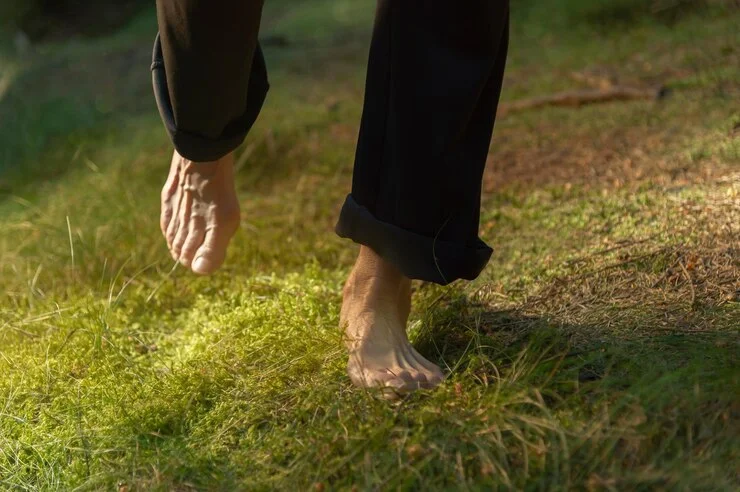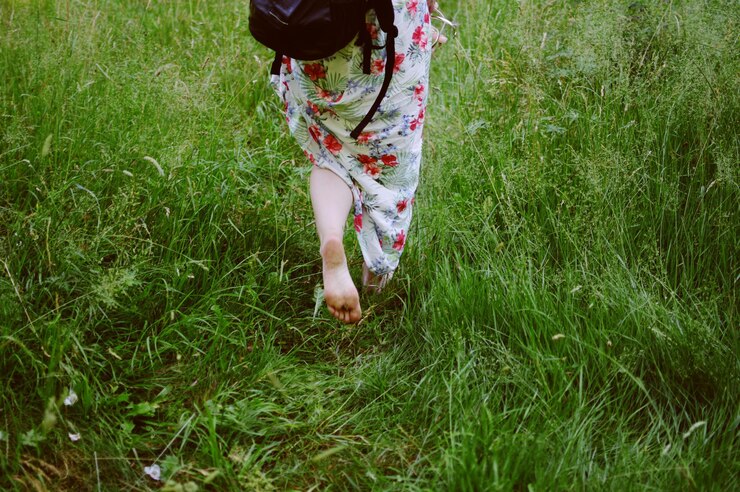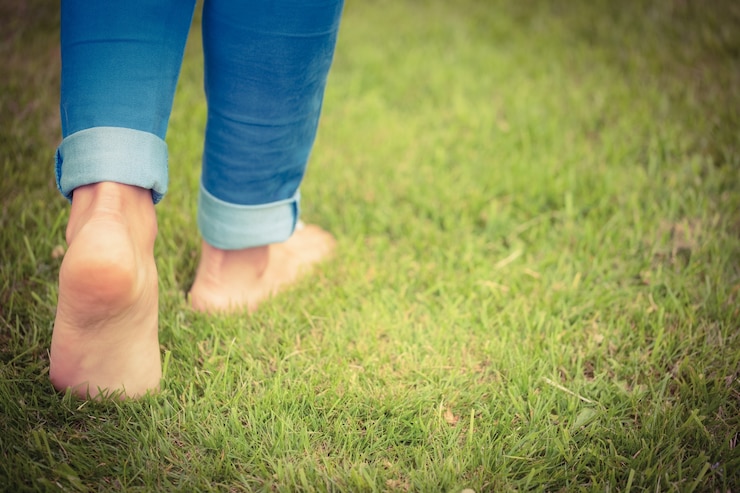Ask Ayurvedic doctor a question and get a consultation online on the problem of your concern in a free or paid mode. More than 2,000 experienced doctors work and wait for your questions on our site and help users to solve their health problems every day.
Shop Now in Our Store
Walking on Grass: An Ayurvedic Insight

Key Takeaways
-
Walking on grass is an ancient Ayurvedic practice that harmonizes mind and body, enhancing your connection to the earth.
- Barefoot walking provides grounding benefits, reducing stress and improving mental clarity in line with Ayurvedic principles.
- Grass walking offers health advantages such as improved circulation and mood enhancement, supported by both Ayurvedic wisdom and modern science.
- The concept of barefoot Ayurveda emphasizes the importance of walking without shoes for holistic wellness, aligning with Ayurvedic teachings.
- Practical tips are available to help you start incorporating grass walking into your routine, maximizing its ancient health benefits.
Walking barefoot on grass might seem like a simple pleasure, but it holds deeper benefits tied to ancient practices like Ayurveda. This natural act connects us to the earth, offering a refreshing escape from the daily grind. The sensation of grass beneath our feet can soothe and revitalize, potentially improving our well-being. Throughout this article, we'll explore the insights and facts surrounding walking on grass, its Ayurvedic roots, and the grounding benefits it provides. Discover how this simple practice can enhance your life and bring a touch of tranquility to your routine. Let's walk this path together and uncover the serene power of nature.

Connecting with Nature
Walking on grass isn't just about feeling the earth beneath your feet. It's a way to connect with nature, a practice deeply rooted in Ayurveda. This ancient wisdom suggests that spending time in nature can balance our energies and promote well-being. A study published by the Environmental Health Perspectives journal found that people who spend more time in natural settings experience lower stress levels.
Imagine stepping onto a lush, green lawn. The soft grass underfoot, the gentle rustle of leaves—it's grounding. This connection, often called "grounding," helps reduce anxiety and improve mood. When we walk barefoot, we're not just strolling; we're absorbing the earth's electrons, which can have calming effects. Embracing this simple act can lead to significant health benefits.

Health Perks of Grass Walking
Walking on grass isn't just a pleasant way to spend your time; it's packed with health benefits. One significant perk is stress reduction. When your feet touch the grass, it can help calm your mind. According to a study published in the Journal of Environmental Psychology, just 20 minutes in a natural setting can lower stress hormone levels by up to 15%. That's a big difference for anyone needing a mental break.
Another benefit is improved balance and posture. Walking barefoot on uneven surfaces like grass can activate muscles in your feet and legs. This activation strengthens those muscles, assisting in better stability and coordination. Think of it as a mini workout for your feet without hitting the gym.
Grass walking also connects you with nature, promoting a sense of well-being. In Ayurveda, an ancient Indian health system, this practice is known as "grounding." Grounding benefits include improved mood and reduced inflammation. The theory is that direct contact with the earth allows you to absorb beneficial electrons, which can boost your health.
Lastly, it’s a great way to soak up vitamin D. Spending time outdoors when the sun is shining helps your body produce this essential nutrient. Vitamin D supports bone health and immune function. Just make sure to apply sunscreen to protect your skin if you're out for long periods.
Barefoot Ayurveda Explained
Walking barefoot, a practice deeply embedded in Ayurveda, offers a unique connection between our bodies and nature. This practice isn't just about feeling the cool grass underfoot; it's a holistic approach to health and well-being.
Ayurveda, an ancient Indian system of medicine, emphasizes balance in the body, mind, and spirit. Walking barefoot on grass is a key element in this balance. It's believed to ground us, literally and metaphorically, by reconnecting us with the earth's energy.
The concept of grounding, or earthing, suggests that direct contact with the earth helps neutralize free radicals in the body. This can lead to various health benefits, such as improved sleep, reduced inflammation, and enhanced mood. The earth's electrons transfer to our body, promoting a sense of calm and well-being.
Here’s how barefoot Ayurveda works:
-
Direct Connection: Walking on grass without shoes allows the soles of our feet to absorb the earth’s energy. This direct contact is essential for grounding.
-
Stimulates Reflex Points: The soles of our feet have numerous nerve endings. Walking on uneven surfaces like grass can stimulate these points, potentially improving organ function.
-
Boosts Immunity: Regular practice can enhance the body's natural defenses by reducing stress and improving circulation.
-
Reduces Stress: The simple act of walking barefoot can lower cortisol levels, helping to reduce stress and anxiety.
To incorporate barefoot walking into daily life, start with short sessions. Choose a safe, grassy area, and begin with a few minutes each day, gradually increasing the time. Pay attention to how it feels—not just on your feet but how it affects your mood and energy levels.
Embracing barefoot Ayurveda isn't just a physical act; it's a mindful practice that can enrich your daily routine. Whether you’re seeking stress relief or a deeper connection with nature, this simple practice can offer profound benefits.
Getting Started with Grass Walking
Walking on grass is more than just a pleasant activity. It connects you with nature and offers health benefits. Grounding, or walking barefoot, can improve your mood and reduce stress. It’s a simple practice that fits well with Ayurvedic principles, promoting balance in your life.
To start, find a safe and clean patch of grass. Remove your shoes and socks, feeling the earth beneath your feet. Take a few deep breaths and walk slowly, focusing on each step. Notice how your feet feel on the grass. This mindful practice can enhance your grounding experience.
If you’re new to Ayurveda, grass walking is an easy way to begin. It helps you connect with the natural world, which is a key aspect of Ayurvedic living. Try to make it a part of your daily routine. A short walk each day can make a big difference in how you feel.
Share your experiences with others. Tell them about the benefits you’ve noticed. Encourage them to try it too. Talk about it on social media or in person. Your story might inspire someone else to step onto the grass.
Explore more about Ayurveda and grounding. There’s so much to learn and experience. You can find more articles, books, or videos that offer deeper insights. Dive into the world of natural healing and well-being. Your journey to better health can start with something as simple as walking on grass.
FAQ For Walking on Grass
What is the significance of walking on grass according to Ayurveda?
Walking on grass is an ancient Ayurvedic practice that helps harmonize the mind and body. It fosters a deeper connection to the earth, promoting balance and well-being through natural exercise.
How does walking barefoot on grass help me connect with nature?
Walking barefoot on grass allows you to physically connect with the earth, which can reduce stress and improve mental clarity. This practice echoes Ayurvedic principles that emphasize grounding and enhancing one's connection with nature.
What are the health benefits of walking on grass?
Walking on grass can enhance circulation, boost mood, and improve overall health. These benefits are supported by Ayurvedic wisdom and modern science, highlighting its effectiveness in promoting holistic wellness.
What is barefoot Ayurveda, and why is it important?
Barefoot Ayurveda is the practice of walking without shoes, aligning with Ayurvedic teachings. It's significant because it offers a simple, natural way to improve holistic health by encouraging a direct connection with the earth.
Can walking on grass improve my mental health?
Yes, walking on grass can improve mental health by reducing stress and enhancing mental clarity. The natural environment and grounding effects of grass walking align with Ayurvedic practices to support mental well-being.
How can I start incorporating grass walking into my daily routine?
To start grass walking, find a safe, grassy area to walk on, and begin by spending a few minutes each day walking barefoot. Gradually increase the time as you become more comfortable, ensuring you gain the maximum benefits from this practice.
Is there a specific time of day that is best for walking on grass?
While you can walk on grass at any time, early morning is often recommended in Ayurveda. The freshness of the morning air and dew on the grass can enhance the grounding and rejuvenating effects of this practice.
This article is checked by the current qualified Dr Sujal Patil and can be considered a reliable source of information for users of the site.

